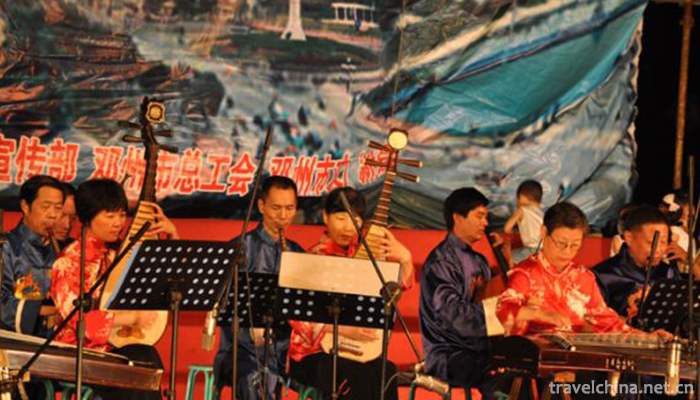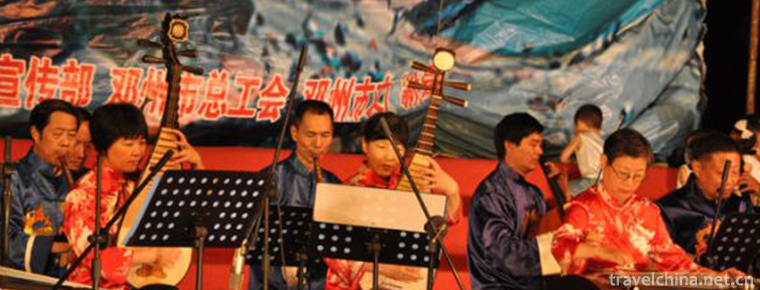Silk Strings of Laohekou
Silk Strings of Laohekou
Laohekou Silk String is a traditional folk music in Xiangyang City, Hubei Province. Laohekou Silk String is different from other forms of folk literature and art. It is a music that combines folk artists'performances with literati's bachelor's self-entertainment.
On June 7, 2008, the silk string of Laohekou was listed in the second batch of national intangible cultural heritage list with the approval of the State Council.
historical origin
In history, Laohekou is a drought dock. It is not only a gathering place for businessmen and businessmen, but also a gathering place for artists from all walks of life. It is known as "Xiaohankou". As early as the Qianlong reign of the Qing Dynasty, silk string music was spread in Yuanguanghua County (now Laohekou City). The silk strings of Laohekou, which are separated from the prelude of "major tunes" by silk strings and have undergone evolution, have strong local characteristics. It has rich repertoire, simple style, elegant charm, euphemistic melody, beautiful and beautiful. As a result of long-term evolution, it has strong local characteristics of folk music in Northwest Hubei and strong regionalism.
artistic characteristics
Laohekou Silk String is different from other traditional folk art forms. It is a music that combines folk artists'performing arts with literati's bachelor's self-entertainment. In those days, businesses and large families in Laohekou often held salon-like parties. At the party, playing the silk strings of Laohekou is an indispensable procedure. After the guests and hosts have sat down separately, each of them will perform a part. Whoever's turn is, he stands up, picks up the toothboard, and makes a respectful snub to everyone. After he has finished offering ugliness, the silk string rings, and the man sings a paragraph.
Representative works
In addition to homesickness, spring and love, there are more than 20 pieces of music, such as Alpine Running Water, Goose Beating, Autumn Appreciation, Xiaoqiao Week, Boudoir Complaint, Chen Xingzhi Courtyard, Chen Xingzhi He Fan and so on. All the above songs are included in Hubei Volume of "Integration of Chinese Ethnic and Folk Instrumental Music".
Inheritance significance
After the founding of New China, Laohekou City established the "National Music Research Society", which mainly plays and studies gongs and drums (commonly known as gongs and drums shelves) and silk strings of Laohekou. Later, "National Music Research Society" developed to 72 people. During festivals and festive gatherings, the team of "National Music Research Society" always ranks first. The dragon and Phoenix flag opens, and the scene is very spectacular.
With the beginning of the Cultural Revolution, these traditional cultures have been impacted. With the death of the old artists, the silk string of the elegant old estuary is in danger of being lost.


-
1.zhangjiajie national forest park Avatar Filming place
Zhangjiajie national Forest Park is located in Zhangjiajie City, northwest of Hunan province. On September 25, 1982, with the approval of the State Council of the People's Republic of China
Time 2018-10-28 -
2.Wulong Karst Tourist Area Movie Transformers Place
Wulong Karst Tourist Area is located in Wulong District of Chongqing City. It has rare natural karst landscape, including karst caves, Tiankeng, ground crevices, canyons, peaks, alpine grasslands, etc
Time 2018-12-12 -
3.Gucun Park Shanghai
Gucun Park is located in Gucun Town, Baoshan District, from north to Shapu, south to Jiazaobang, and adjacent to Huanbei Avenue of the Outer Ring Road,
Time 2018-12-19 -
4.Linhe Yellow River National Wetland Park Inner Mongolia
Inner Mongolia Linhe Yellow River National Wetland Park is located in Linhe District, Bayannaoer City, Inner Mongolia Autonomous Region, with a total area of 4637.6 hectares. The functional zoning map
Time 2018-12-26 -
5.Yuexiu Park Guangzhou
Yuexiu Park is the largest comprehensive park in Guangzhou. The main body of Yuexiu Park is Yuexiu Mountain. In the Western Han Dynasty, Zhao Tuo, the king of South Vietnam, was named after the "
Time 2019-01-13 -
6.Zaozhuang Old Street Shuicheng South Shandong
Shuicheng Zaozhuang Old Street in Southern Shandong Province is located in the middle section of Xichang Road in the Central District of Zaozhuang City, Shandong Province.
Time 2019-02-06 -
7.Firing Techniques of Jieshou Coloured Pottery
The firing technique of Jieshou colored pottery, the local traditional handicraft technique of Jieshou City, Anhui Province, is one of the national intangible cultural heritages.
Time 2019-05-06 -
8.Mongolian Sihu Music
Mongolian Sihu music is one of China's intangible cultural heritage. Mongolian Sihu is one of the most distinctive Mongolian musical instruments, stringed instruments.
Time 2019-06-04 -
9.Quyi
Quyi is the general name of all kinds of "rap art" of the Chinese nation. It is a unique art form formed by the long-term development of folk oral literature and singing art. According to in
Time 2019-06-11 -
10.Wuhan acrobatics
In the 20 years of Qingdaoguang (1840), folk acrobats from Tianmen, Wuyang and other places in Hubei came to Wuhan to perform, and then gradually formed a class club to enter the stage. Folk artists s
Time 2019-06-30 -
11.The second industry of Panzhihua
In 2018, the total industrial added value of Panzhihua was 69.163 billion yuan, an increase of 7.0%, and its contribution rate to economic growth was 59.7%. At the end of the year, there were 325 Industrial Enterprises above designated size. The production and sales rate
Time 2020-12-14 -
12.Mianyang tertiary industry
In 2019, the added value of the tertiary industry in Mianyang will increase by 9.4%, 0.9 percentage points higher than the average level of the whole province. Among them, the added value of wholesale and retail industry increased by 9.5%, transportation
Time 2020-12-14